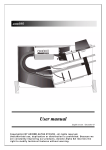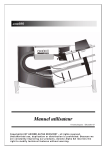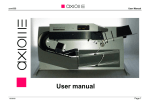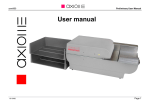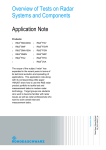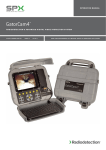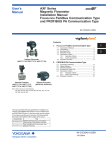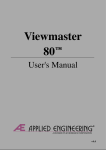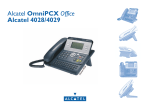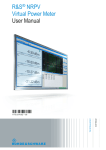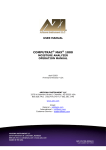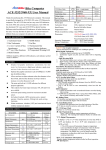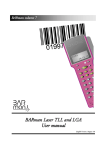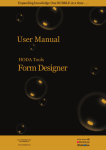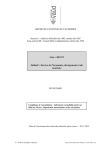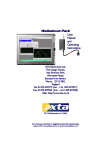Download AXF programming manual
Transcript
AXF programming manual
Copyright(c) BY AXIOME ALPHA 14/04/03 - all rights
reserved.
Unauthorized use, duplication or distribution is prohibited.
AXF
ii
Programming manual
AXF
Table of content
CHAPTER 1 : GENERAL DESCRIPTION ....................................................... 1
General ................................................................................ 1
How to use it ?...................................................................... 1
Changing the parameters ....................................................... 1
File Format ........................................................................... 2
Normal start up ..................................................................... 2
Transferring the " AXF Parameters " .................................. 2
CHAPTER 2 : The communication parameters ................................................ 5
Description of communication parameters................................ 5
Start of document characters ............................................ 5
Start of record characters ................................................. 5
End of record characters .................................................. 5
End of document characters ............................................. 6
Start of error message...................................................... 6
End of error message....................................................... 6
Fill character ................................................................... 6
Quantity of synch characters ............................................ 7
Synch characters ............................................................ 7
Record length.................................................................. 7
Baud rate........................................................................ 7
Uart ................................................................................ 8
Send number of marks read.............................................. 8
Send number of clocks read ............................................. 8
Good sound number......................................................... 9
Error sound number ......................................................... 9
Send errors ..................................................................... 9
Wait for echo..................................................................10
Delay before sending data ...............................................10
Delay after each character...............................................10
Delay after each record ...................................................10
Repeat character ............................................................11
Program number.............................................................11
Checking clock marks.....................................................17
Character to call the next document .................................17
Character to call the next record ......................................17
Character to accept a document ......................................17
Character to reject a document ........................................18
Distance before stopping the paper...................................18
Character to reload parameters ........................................18
Send version number.......................................................18
Character for printing command........................................19
Adjust reading sensibility (only axm 905 / 915) .................19
Read mask ..........................................................................19
Table of communication parameters .......................................20
CHAPTER 3 : Bar-code ...............................................................................23
iii
AXF
Programming manual
CHAPTER 4 : Special binary output format ....................................................25
CHAPTER 5 : Record example.....................................................................27
CHAPTER 6 : Errors messages....................................................................29
CHAPTER 7 : ASCII characters ....................................................................31
CHAPTER 8 : Hex code description..............................................................35
iv
AXF
Chapter
1
CHAPTER 1 : GENERAL DESCRIPTION
General
This programme is developed in order to enable any user to connect their
AXIOME OMR reader to (almost) any computer. After power-on, it is possible to
send the reader a list of parameters to suit your computer interface.
The parameter file is described in this document.
How to use it ?
When turning the power on, the reader is ready to work with the parameters
used in the last session. The parameters stays in memory until you decide to
change them, or until the battery is defect.
Changing the parameters
When turning the power on, wait for the "M26B" or "Manager 985" message and
push the button on the reader until the message "PARA" or "PARAMETER
PLEASE" is displayed. This message is automatically displayed if the
parameters are corrupted. If you don't push the button, the reader will use the
parameter from the last session as far as they are uncorrupted. ( a memory
check will be made at every power on and new parameters will be requested if
the data are false).
Loading the parameters will be always done at 9600 Baud No-parity, 8 bits,
1 stop.
After loading the parameters, the baudrate ,the parity, the length, and
the stop bits will be changed according to the value specified in the
parameter file downloaded.
1
AXF
Programming manual
File Format
The @AXF string is used to indicate the start of the parameter file. Any other
comment without any restriction may be written on the file before this string.
After @AXF, the order of the parameters, and the number of data is very
important and must not be changed. After @AXF, comments are allowed IF
they don't use characters between 30H and 47H . That mean that comment
written in lowercase characters are allowed.
The string @MASK 48 TRACKS is used as separator and to indicates the
format for the mask. The format may be either 00 (no mask), 12, 40 or 48 tracks
after the last bit of the mask, the string @END must follow without any other
character
Normal start up
Transferring the " AXF Parameters "
The AXF parameter software loaded with firmware (refer to Transferring
"Firmware" from user manual), runs with parameters that were sent as a file to
the reader. They stay in memory until the next transfer of a new parameter file.
When first installing an reader using AXF, the parameter file must be
transferred. A simple COPY allows you to send this file to the reader.
Transferring the DEFAULT.AXF parameter file to the reader.
Switch the reader on ( switch ON ) and press the START-button as soon as the
reader displays "MAN xVx". Hold the button pressed down until the reader
displays "PARAM". The reader is now ready to receive new parameters.
2
AXF
Chapter
1
Communication :
The transfer will be done at 9600 bauds, 8 data, no parity and 1 stop bit.
Warning !!!
This manipulation will delete the old AXF parameters in
the reader's memory.
Insert the axm 930, 990, 995 disk or the OMR Reader utilities disk in Drive A
or B of your PC.
To copy the parameter file (DEFAULT.AXF e.g.) type :
A: Enter ↵
or
B: Enter ↵
MODE COM1: 9600,N,8,1
COPY DEFAULT.AXF COM1 Enter ↵
If the transfer to the reader has been successfully accomplished, the message
"CDE Sx" will be displayed.
3
AXF
4
Programming manual
AXF
Chapter
2
CHAPTER 2 : The communication parameters
The communication parameter part allows you to adapt many communication
parameters to your needs.
The @AXF string is used to indicate the start of the parameter part.
After @AXF, the order of the parameters, and the number of data is very
important and must not be changed.
In this part, characters between 30H and 45H are not allowed . That mean that
comment written in lowercase characters are allowed.
Description of communication parameters
Start of document characters
Up to 3 characters may be defined to be sent before each document. The fourth
character (FF Hex) have not to be modified.
AXF parameter example :
start of document characters
01 FF FF FF
= SOH
Start of record characters
Up to 3 characters may be defined to be sent before each record. The fourth
character (FF Hex) have not to be modified.
AXF parameter example :
start of record characters
02 FF FF FF
= STX
End of record characters
Up to 3 characters may be defined to be sent after each record. The fourth
character (FF Hex) have not to be modified.
AXF parameter example :
end of record characters
0D 0A 03 FF
= CR LF ETX
G The comments in italic font must not be included on the parameter file
5
AXF
Programming manual
End of document characters
Up to 3 characters may be defined to be sent after each document. The fourth
character (FF Hex) have not to be modified.
AXF parameter example :
end of document characters
04 FF FF FF
= EOT
Start of error message
Up to 3 characters may be defined to be sent before each error message. The
fourth character (FF Hex) have not to be modified.
AXF parameter example :
start of error message
15 FF FF FF
= NAK
End of error message
Up to 3 characters may be defined to sent after each error message. The fourth
character (FF Hex) have not to be modified.
AXF parameter example :
end of error message
0D 0A 03 FF
= CR LF ETX
Fill character
If the record has a defined length, the end of the record may have to be filled
with the character defined here.
AXF parameter example :
fill character
6
2E
= "." character
AXF
Chapter
2
Quantity of synch characters
This function allow to define a quantity X of characters Y (see 2.1.9) at the
beginning of the record. These characters are counted by the record length
counter.
AXF parameter example :
qty of synch characters
0E
= 14 characters
Synch characters
The ASCII value of the chosen character.
AXF parameter example :
synch character
2D
= "-" character
Record length
The length of the record may be variable (in this case Isb Hex 00 and msb Hex
00) or fixed. The record length has to be coded in binary.
If the value is different to 0, each record will be truncated at this value and the
last record will be filled if necessary. This record value could be variable
between Isb 00, msb 00 and Isb E0, msb 2E ( 0 to 12000 decimal)
AXF parameter example :
record length lsb hex
record length msb hex
28
00
= 40 decimal
= 00 decimal
Baud rate
The baud rate may be chosen as follow :
1 = 1200 , 2 = 2400 , 3 = 4800 , 4 = 9600 , 5 = 19200 , 6 = 38400 bds
AXF parameter example :
G The comments in italic font must not be included on the parameter file
7
AXF
Programming manual
baud rate
04
= 9600 bauds
Uart
The UART mode may be selected with the next 4 bytes as follow :
word length (data bits) 02= 7 bits,
parity enable
00 = no parity,
parity
00 = odd,
stops bits
01 = 1 stop
03 = 8 bits
01 = parity on
01 = even
03 = 2 stops
AXF parameter example :
word length
parity enable
parity even
stops bits
03
00
01
01
In this example, the UART mode is : 8 bits, no parity, even parity, 1 stop bit
Send number of marks read
The reader can compute the quantity of reading marks it founds on the
document. The read send this value as a 4 characters decimal.
00 = not sent
01 = sent
AXF parameter example :
send number of marks read
00
= not sent
Send number of clocks read
The reader can also send the quantity of clock marks (or timing marks or lines)
it read. The reader send this value as 3 characters decimal.
00 = not sent clock
01 = sent clock
AXF parameter example :
send number of clocks read
8
00
= not sent clock
AXF
Chapter
2
Good sound number
This option gives you the mean to produce a sound each time a document has
been selected into the "good" hopper.
00
01
02
03
04
05
06
=
=
=
=
=
=
=
no sound
very short medium
short medium
normal medium
(not active)
alarm
modulated sound
AXF parameter example :
bip number as ok
00
= no sound
Error sound number
This option produces a sound after a document has been "rejected", same
values as above (see good sound number)
AXF parameter example :
bip number as ko
05
= alarm
Send errors
This option will switch on or off, the sending of error messages on the serial
output, when errors occurs.
00 does not send
01 = send errors
AXF parameter example :
send error messages
01
= send errors
G The comments in italic font must not be included on the parameter file
9
AXF
Programming manual
Wait for echo
If 01 is selected for this option, after each character sent to the host, the reader
will wait until it become the same character back.
00 = no wait
01 = wait for echo
AXF parameter example :
wait for echo
00
= no wait
Delay before sending data
You may define how many 50 milliseconds (0 to FF) the reader must wait
before sending the first data of a document.
AXF parameter example :
delay before sending data
0A
= 10 step of 50 milliseconds
Delay after each character
You define here how many milliseconds (0 to FF) the reader must wait after
sending each character
AXF parameter example :
delay after each character
0C
= 12 milliseconds
Delay after each record
You define here how many milliseconds (0 to FF) the reader must wait after
each record.
10
AXF
Chapter
2
AXF parameter example :
delay after each record
1F
= 31 milliseconds
Repeat character
The character defined here (ASCII) is need to transmit again, the contents of the
last document.
AXF parameter example :
character to repeat the document 52
= R character
Program number
This parameter let choose the output format you wish to use.
01
02
03
04
05
=
=
=
=
=
every marked mark will generate its co-ordinates as 4 characters.
each marked line will be transmitted in Hex format.
each line will be transmitted in hex format
all the documents is transmitted in image format
only the marked lines will be transmitted in image mode.
Special binary output format only for axm 990 / 995.
06 =
07 =
each marked line will be transmitted in a special binary format.
only the marked lines will be transmitted in a special binary format.
The image of the document will be transmitted in binary format with 8 read cells
coded in each byte, that means each byte can take a value from 00 to FF and it
is no more possible to use special character like CR as terminator. To get
round this annoyance we suggest to use the first byte of each block as a flag
and the number of expected bytes following this flag can be found by the type of
flag.
Flag byte :
01...78
F1
F2
F3
F4
F9
= clock number (binary hex value, max 120 clocks)
= end of side 1 (binary hex value)
= end of side 2 (binary hex value)
= external data like bar-code (binary hex value)
= error message (binary hex value)
= end of document (binary hex value)
G The comments in italic font must not be included on the parameter file
11
AXF
Programming manual
AXF parameter example :
program number
12
01 = co-ordinates as 4 characters
AXF
Chapter
G The comments in italic font must not be included on the parameter file
2
13
AXF
14
Programming manual
AXF
Chapter
G The comments in italic font must not be included on the parameter file
2
15
AXF
16
Programming manual
AXF
Chapter
2
Checking clock marks
If this value is = 0, the number of clockmarks will not be checked.
If this value is > 0, then the number of clock marks will be compared with this
value.
If a difference exists, the document will be rejected.
00 = no check, >00 = reject if not equal
AXF parameter example :
checking clock marks
28
= test if quantity of clock mark is = 40
Character to call the next document
The reader waits for the character defined here to initiate a read cycle. If this
value is 00, the reader reads continuously.
AXF parameter example :
character to call the next document 4C
= R character
Character to call the next record
The reader waits for the character defined here to send the next record. If this
value is 00, the reader doesn't wait.
AXF parameter example :
character to call the next record
00
= doesn't wait
Character to accept a document
The reader waits for the character defined here to eject a document as good.
If this value is 00, the reader eject automatically according to the tests
performed by ADELE, and the action defined by the program.
AXF parameter example :
character to accept a document
47
= G character
G The comments in italic font must not be included on the parameter file
17
AXF
Programming manual
Character to reject a document
The reader waits for the character defined here to reject a document to the false
tray.
AXF parameter example :
character to reject a document
53
= S character
Distance before stopping the paper
In order to read a Bar-code label at the end of a document, some readers need
to stop the document later. The value means a number of steps of 0.5mm ( valid
from 0 to 255 ).
AXF parameter example :
distance before stopping the paper
14
=14 steps = 7 1mm later
Character to reload parameters
This parameter enables the user to reload a new parameters set anytime,
without to press the button. If this character is received while the reader is
waiting for feeding the next document, the reader will expect the new
parameters set.
The default value for this parameter is ESC ( 1B Hex ).
AXF parameter example :
Character to reload parameters
1B
= ESC
Send version number
This parameter defines the character to send for asking the version number. The
character defined here will be answered only when the reader is expecting the
character to call the next document, or is waiting for parameters.
AXF parameter example :
18
AXF
Chapter
character to send version number 56
2
= V character
Character for printing command
This parameter defines the character you have to send for printing the string.
AXF parameter example :
character for printing command
50
= P for printing command
Adjust reading sensibility (only axm 905 / 915)
This parameter is need for adjusting the reading sensibility on the AXM 915. The
sensibility between 01 and 07 is adjusted form the RS232 line.
AXF parameter example :
adjust reading sensibility
05
= set reading sensibility to 5
Read mask
A mask may be loaded to select ON ( 1 ) or OFF ( 0 ) each of the 48 hardware
tracks of the reading head.
@ must follows the last character of the table, without any other character the
mask will be completed with zeroes until the end of the buffer.
AXF mask example :
@mask40 tracks
1111111111111111111111111111111111100000@end
The track 1 to 5 are masked ( no mark read ) and the track 6 to 40 are enabled.
For no mask :
@mask00 tracks
@end
G The comments in italic font must not be included on the parameter file
19
AXF
Programming manual
Table of communication parameters
(ASCII : any value between 00 and FE)
@AXF
start of document characters
start of record characters
end of record characters
end of document characters
start of error message characters
end of error message characters
character to fill the record
qty of synch characters
heading character
record length lsb hex
record length msb hex
baud rate
01 FF FF FF
02 FF FF FF
0D 0A 03 FF
04 FF FF FF
15 FF FF FF
0D 0A 03 FF
2E
00
2D
28
00
04
ASCII
"
"
"
"
"
"
0 to 255 (binary)
ASCII
0 for variable length
0 for variable length
1=1200,2=2400,3=4800,4=9600,5=19200,6=38400
uart
word length seven or eight bits
parity enable
parity even
stops bits
send quantity of marks read
send quantity of clocks read
bip number as ok
bip number as ko
send error messages
wait for echo
delay before sending data (fifty ms)
delay after each character (one ms)
delay after each record (one ms)
repeat character
program number
checking clock marks
character to call the next document
character to call the next record
character to accept a document
character to reject the last doc.
distance before stopping the paper
character to reload parameters
character to send version number
character for printing command
reserved
reserved
adjust reading sensibility
comments :
03
00
01
01
00
00
00
05
01
00
00
00
00
52
04
00
4C
00
47
53
00
1B
56
50
00
00
05
@MASK 40 TRACKS
either 00, 12, 40, or 48 tracks only
20
02= 7 bits,
03 = 8 bits
00 = no parity,
01 = parity on
00 = odd,
01 = even
01 = 1 stop
03 = 2 stops
00 = not sent,
01 = send # marks
00 = not sent,
01 = send # clocks
00,01,02,03,05,06
00,01,02,03,05,06
00 does not send 01 = send errors
00 = no wait
01 = wait for echo
00 to 255 (binary)
00 to 255 (binary)
00 to 255 (binary)
ASCII, 00 = no wait
01 to 07 ( see output format )
00 = no check, >01 = reject if not equal
ASCII, 00 = no wait
ASCII, 00 = no wait
ASCII, 00 = no wait
ASCII
00 to 255 (binary) (1 unit = 0.5mm)
ASCII 01 to FF
ASCII
00 no printing command
01 to 07 (only for axm 915)
AXF
Chapter
2
0000000000000000000000000000000000000000
The two first lines are masked.
0000000000000000000000000000000000000000
1111111111111111111111111111111111111111
one CR character MUST
1111111111111111111111111111111111111111
end each line
1111111111111111111111111111111111111111
1111111111111111111111111111111111111111
1111111111111111111111111111111111111111@END
G The comments in italic font must not be included on the parameter file
21
AXF
22
Programming manual
BARCODE
Chapter
3
CHAPTER 3 : Bar-code
The bar-code buffer contents the data read from the bar-code in the following
format.
The bar-code data follows the OMR data.
"[Cxxxx]yyyyyyyy"
C = Bar-code type :
I = interleaved 2/5 forward
J = interleaved 2/5 backward
A= codabar forward
B= codabar backward
C= code 128 for and backward
E= code 39 forward
F= code 39 backward
T= EAN 8 or 13 forward
S= EAN 8 or 13 backward
xxxx
yyyyy
#
=
=
# Distance until the end of the document
Bar-code value
Presently this value can't be converted in mm because the reliability
is not guaranteed.
23
AXF
24
Programming manual
SPECIAL BINARY OUTPUT
Chapter
4
CHAPTER 4 : Special binary output format
This chapter is a technical description of the program number 06 and 07 (see
Program number, page 11).
That means that the dialogue to control the axm reader remains the same as
the program number 01 to 05. Only the read data output by the machine are
specific.
The image of the document will be transmitted in a binary format with 8 read
cells coded in each byte, that means each byte can take a value from 00 to FF
and it is no more possible to use special character like CR as terminator. To
get round this inconvenience we suggest to use the first byte of each block as a
flag and the number of expected bytes following this flag can be found by the
type of flag.
Transmit protocol
Data bits
8 bits
Data for a clock
Flag byte
Number of following bytes
Organisation of block
Organisation of byte
01 .. 78 = clock number (binary hex value, max.
120 clocks)
6
first byte = channels 48 to 41, last byte 8 to 1
LSB = lower channel (i.e. channel 1) MSB = higher
channel (i.e. channel 8)
Note :
In the program number 06, the reader send all the read clocks disregarding if
some channels are marked or not.
In the program number 07, only the marked lines are sent.
End of side 1
Flag byte
Number of following bytes
F1 (binary hex value) (no displayable on a terminal)
0
End of side 2
Flag byte
Number of following bytes
F2 (binary hex value) (no displayable on a terminal)
0
25
AXF
Programming manual
External data (bar-code)
Flag byte
Number of following bytes
Organisation of block
F3 (binary hex value) (no displayable on a terminal)
variable
first byte of block = delimiter, followed by ASCII
string, followed by the same delimiter as in the first
byte of block (example : "123456ABCD...")
Error message
Flag byte
Number of following bytes
Organisation of block
F4 (binary hex value) (no displayable on a terminal)
variable
same as external data (the content of the message
itself is the same as in the other modes of AXF).
End of document
Flag byte
Number of following bytes
F9 (binary hex value) (no displayable on a terminal)
0
Stream of data for 1 document
1.
2.
3.
4.
5.
6.
Data of side 1 (if any)
01 xx xx xx xx xx xx
...
nn xx xx xx xx xx xx
End of side 1 flag
F1
Data of side 2 (if any)
01 xx xx xx xx xx xx
...
nn xx xx xx xx xx xx
End of side 2 flag
F2
F3 + external data (if any) F3 22 . . . . . . . . 22 (bar-code)
End of document flag
F9
That means even for an empty document F1, F2, F9 will be sent.
26
RECORD EXAMPLE
Chapter
5
CHAPTER 5 : Record example
Record example with the Table of communication parameters from the page 20.
27
AXF
28
Programming manual
ERRORS MESSAGES
Chapter
6
CHAPTER 6 : Errors messages
Nr
Messages on
16 digit display
1
2
3
4
5
6
7
8
9
10
11
12
13
14
15
16
17
18
19
20
21
22
23
24
25
26
27
28
64
BAD FEEDING
JAM BEFORE HEAD
JAM UNDER HEAD
JAM AFTER HEAD
JAM IN SORTING
NO SHEET ON LIFT
BAD TRAY FULL
GOOD TRAY FULL
SHEET TOO SHORT
SHEET TOO THIN
SHEET TOO THICK
SHEET TOO LONG
INCORRECT SHEET
INCORRECT PARITY
BAUDRATE ?
IENSITIVITY ?
LOW BATTERY
BAD RETENTION
NO SHEET TO SORT
PATH NOT FREE
NO BLACK GAUGING
NO DECODER
LIFT ERROR
CALIBRATE
GOOD TRAY ERROR
SECURITY STOP
NO SHEET IN GOOD
NO SHEET IN BAD
PAUSE
Messages on
4 digit display
FEED
JAMB
JAMH
JAMA
SORT
PAPR
REMARKS
(AFTER 3 ATTEMPTS)
(WHEN REJECTING)
(SHEET INTO THE READER)
BLAC
(axm995 only)
(axm990/995)
(axm990/995)
(axm990/995)
29
AXF
30
Programming manual
ASCII CHARACTERS
Chapter
7
CHAPTER 7 : ASCII characters
OCTAL
DEC
HEX
CHRS
CTRL KEY
000
001
002
003
004
005
006
007
010
011
012
013
014
015
016
017
020
021
022
023
024
025
026
027
030
031
032
033
034
035
036
037
040
041
042
043
044
045
046
047
050
051
052
053
054
0
1
2
3
4
5
6
7
8
9
10
11
12
13
14
15
16
17
18
19
20
21
22
23
24
25
26
27
28
29
30
31
32
33
34
35
36
37
38
39
40
41
42
43
44
0
1
2
3
4
5
6
7
8
9
A
B
C
D
E
F
10
11
12
13
14
15
16
17
18
19
1A
1B
1C
1D
1E
1F
20
21
22
23
24
25
26
27
28
29
2A
2B
2C
<NUL>
<SOH>
<STX>
<ETX>
<EOT>
<ENQ>
<ACK>
<BEL>
<BS>
<HT>
<LF>
<VT>
<FF>
<CR>
<SO>
<SI>
<DLE>
<DC1>
<DC2>
<DC3>
<DC4>
<NAK>
<SYN>
<ETB>
<CAN>
<EM>
<SUB>
<ESC>
<FS>
<GS>
<RS>
<US>
<SP>
<!>
<">
<#>
<$>
<%>
<&>
<'>
<(>
<)>
<*>
<+>
<,>
@
A
B
C
D
E
F
G
H
I
J
K
L
M
N
O
P
Q
R
S
T
U
V
W
X
Y
Z
[
\
]
^
_
DESCRIPTION
Null, tape feed.
Start of heading.
Start of text.
End of text.
End of transmission.
Enquiry, also WRU.
Acknowledge, also RU.
Rings the bell.
Backspace, also FEB.
Horizontal tab.
Line feed, adv. cursor to next line.
Vertical tab (VTAB).
Form feed to top of next page.
Carriage return to beginning of line.
Shift out.
Shift in.
Data line escape.
Device ctrl 1,turns transm. on ,XON.
Device ctrl 2.
Device ctrl 3,turns transm. off ,XOFF
Device ctrl 4.
Negative acknowledge, also ERR .
Synchronous idle (SYNC).
End of transmission block.
Cancel (CANCL), escape sequence.
End of medium.
Substitute.
Escape.
File separator.
Group separator.
Record separator.
Unit separator.
Space.
Exclamation point.
Quotation mark
Number sign.
Dollar sign.
Percent sign.
Ampersand.
Acute accent or apostrophe.
Open parenthesis.
Close parenthesis.
Asterisk.
Plus sign.
Comma.
31
AXF
Programming manual
OCTAL
DEC
HEX
CHRS
055
056
057
060
061
062
063
064
065
066
067
070
071
072
073
074
075
076
077
100
101
102
103
104
105
106
107
110
111
112
113
114
115
116
117
120
121
122
123
124
125
126
127
130
131
45
46
47
48
49
50
51
52
53
54
55
56
57
58
59
60
61
62
63
64
65
66
67
68
69
70
71
72
73
74
75
76
77
78
79
80
81
82
83
84
85
86
87
88
89
2D
2E
2F
30
31
32
33
34
35
36
37
38
39
3A
3B
3C
3D
3E
3F
40
41
42
43
44
45
46
47
48
49
4A
4B
4C
4D
4E
4F
50
51
52
53
54
55
56
57
58
59
<->
<.>
</>
<0>
<1>
<2>
<3>
<4>
<5>
<6>
<7>
<8>
<9>
<:>
<;>
<<>
<=>
<>>
<?>
<@>
<A>
<B>
<C>
<D>
<E>
<F>
<G>
<H>
<I>
<J>
<K>
<L>
<M>
<N>
<O>
<P>
<Q>
<R>
<S>
<T>
<U>
<V>
<W>
<X>
<Y>
32
CTRL KEY
DESCRIPTION
Hyphen or minus sign.
Period.
Slash.
Number 0.
Number 1.
Number 2.
Number 3.
Number 4.
Number 5.
Number 6.
Number 7.
Number 8.
Number 9.
Colon.
Semicolon.
Less than.
Equal sign.
Greater than.
Question mark.
At sign.
Letter A.
Letter B.
Letter C.
Letter D.
Letter E.
Letter F.
Letter G.
Letter H.
Letter I.
Letter J.
Letter K.
Letter L.
Letter M.
Letter N.
Letter O.
Letter P.
Letter Q.
Letter R.
Letter S.
Letter T.
Letter U.
Letter V.
Letter W.
Letter X.
Letter Y.
ASCII CHARACTERS
132
90
5A
<Z>
OCTAL
DEC
HEX
CHRS
133
134
135
136
137
140
141
142
143
144
145
146
147
150
151
152
153
154
155
156
157
160
161
162
163
164
165
166
167
170
171
172
173
174
175
176
177
91
92
93
94
95
96
97
98
99
100
101
102
103
104
105
106
107
108
109
110
111
112
113
114
115
116
117
118
119
120
121
122
123
124
125
126
127
5B
5C
5D
5E
5F
60
61
62
63
64
65
66
67
68
69
6A
6B
6C
6D
6E
6F
70
71
72
73
74
75
76
77
78
79
7A
7B
7C
7D
7E
7F
<[>
<\>
<]>
<^>
<_>
<`>
<a>
<b>
<c>
<d>
<e>
<f>
<g>
<h>
<i>
<j>
<k>
<l>
<m>
<n>
<o>
<p>
<q>
<r>
<s>
<t>
<u>
<v>
<w>
<x>
<y>
<z>
<{>
<¦>
<}>
<~>
<DEL>
Chapter
7
Letter Z.
CTRL KEY
DESCRIPTION
Open brackets.
Reverse slash.
Close Brackets.
Up arrow / caret.
Underscore.
Grave accent.
Letter a.
Letter b.
Letter c.
Letter d.
Letter e.
Letter f.
Letter g.
Letter h.
Letter i.
Letter j.
Letter k.
Letter l
Letter m.
Letter n.
Letter o.
Letter p.
Letter q.
Letter r.
Letter s.
Letter t.
Letter u.
Letter v.
Letter w.
Letter x.
Letter y.
Letter z.
Left brace.
Vertical bar (broken).
Right brace.
Tilde.
Delete ( reboot )
33
AXF
34
Programming manual
HEX CODE DESCRIPTION
8
Chapter
CHAPTER 8 : Hex code description
Hex
Binary
01
02
03
04
05
06
07
08
09
0A
0B
0C
0D
0E
0F
10
11
12
13
14
15
16
17
18
19
1A
1B
1C
1D
1E
1F
20
21
...
0000
0000
0000
0000
0000
0000
0000
0000
0000
0000
0000
0000
0000
0000
0000
0001
0001
0001
0001
0001
0001
0001
0001
0001
0001
0001
0001
0001
0001
0001
0001
0010
0010
8
0001
0010
0011
0100
0101
0110
0111
1000
1001
1010
1011
1100
1101
1110
1111
0000
0001
0010
0011
0100
0101
0110
0111
1000
1001
1010
1011
1100
1101
1110
1111
0000
0001
7
6
5
4
3
2
1
1
2
3
4
5
6
7
8
9
10
11
12
13
14
15
16
17
18
19
20
21
22
23
24
25
26
27
28
29
30
31
32
33
34
35
AXF
Programming manual
AXIOME Alpha SA
Rue de la Gare 5a
CH-2035 Corcelles
Switzerland
Tel.
Fax.
++41 (038) 304 620
++41 (038) 316 493
From 09.11.1996
Tel.
++41 (032) 730 46 20
Fax. ++41 (032) 731 64 93
AXIOME GmbH
Herzog-Ludwig-Straße 9
D-85570
Markt
Schwaben
Germany
Tel.
Fax.
36
++49 (08121) 9315-0
++49 (08121) 40250
AXIOME / File AXFANx.DOC / Ref. LIAXPRE.200 / 03.07.1996 /C.W.
HEX CODE DESCRIPTION
Chapter
8
Printed in Switzerland by AXIOME SA
37









































